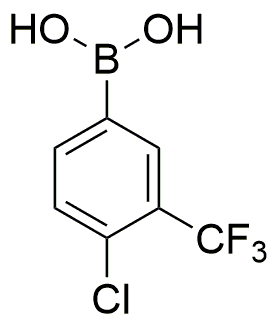4-Chloro-3-(trifluoromethyl)phenylboronic acid is widely utilized in research focused on:
- Pharmaceutical Development: This compound plays a crucial role in the synthesis of various pharmaceuticals, particularly in the development of drugs targeting cancer and other diseases due to its ability to form stable complexes with biologically relevant molecules.
- Organic Synthesis: It is commonly used as a reagent in Suzuki coupling reactions, which are essential for creating complex organic molecules. This application is particularly valuable in the production of agrochemicals and fine chemicals.
- Material Science: The compound is utilized in the development of advanced materials, including polymers and coatings, where its unique properties can enhance durability and performance.
- Analytical Chemistry: It serves as a key component in various analytical techniques, helping researchers detect and quantify specific substances in complex mixtures, which is vital in environmental monitoring and quality control.
- Fluorine Chemistry: The trifluoromethyl group in this compound allows for unique reactivity patterns, making it a valuable tool in fluorine chemistry, which is important for creating new materials with specialized properties.
General Information
Properties
Safety and Regulations
Applications
4-Chloro-3-(trifluoromethyl)phenylboronic acid is widely utilized in research focused on:
- Pharmaceutical Development: This compound plays a crucial role in the synthesis of various pharmaceuticals, particularly in the development of drugs targeting cancer and other diseases due to its ability to form stable complexes with biologically relevant molecules.
- Organic Synthesis: It is commonly used as a reagent in Suzuki coupling reactions, which are essential for creating complex organic molecules. This application is particularly valuable in the production of agrochemicals and fine chemicals.
- Material Science: The compound is utilized in the development of advanced materials, including polymers and coatings, where its unique properties can enhance durability and performance.
- Analytical Chemistry: It serves as a key component in various analytical techniques, helping researchers detect and quantify specific substances in complex mixtures, which is vital in environmental monitoring and quality control.
- Fluorine Chemistry: The trifluoromethyl group in this compound allows for unique reactivity patterns, making it a valuable tool in fluorine chemistry, which is important for creating new materials with specialized properties.
Documents
Safety Data Sheets (SDS)
The SDS provides comprehensive safety information on handling, storage, and disposal of the product.
Product Specification (PS)
The PS provides a comprehensive breakdown of the product’s properties, including chemical composition, physical state, purity, and storage requirements. It also details acceptable quality ranges and the product's intended applications.
Certificates of Analysis (COA)
Search for Certificates of Analysis (COA) by entering the products Lot Number. Lot and Batch Numbers can be found on a product’s label following the words ‘Lot’ or ‘Batch’.
Número de catálogo
Número de lote/lote
Certificates Of Origin (COO)
This COO confirms the country where the product was manufactured, and also details the materials and components used in it and whether it is derived from natural, synthetic, or other specific sources. This certificate may be required for customs, trade, and regulatory compliance.
Número de catálogo
Número de lote/lote
Safety Data Sheets (SDS)
The SDS provides comprehensive safety information on handling, storage, and disposal of the product.
DownloadProduct Specification (PS)
The PS provides a comprehensive breakdown of the product’s properties, including chemical composition, physical state, purity, and storage requirements. It also details acceptable quality ranges and the product's intended applications.
DownloadCertificates of Analysis (COA)
Search for Certificates of Analysis (COA) by entering the products Lot Number. Lot and Batch Numbers can be found on a product’s label following the words ‘Lot’ or ‘Batch’.
Número de catálogo
Número de lote/lote
Certificates Of Origin (COO)
This COO confirms the country where the product was manufactured, and also details the materials and components used in it and whether it is derived from natural, synthetic, or other specific sources. This certificate may be required for customs, trade, and regulatory compliance.


